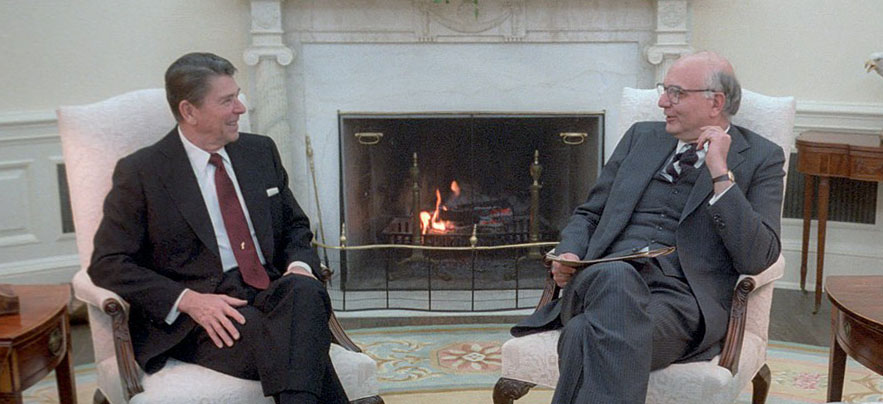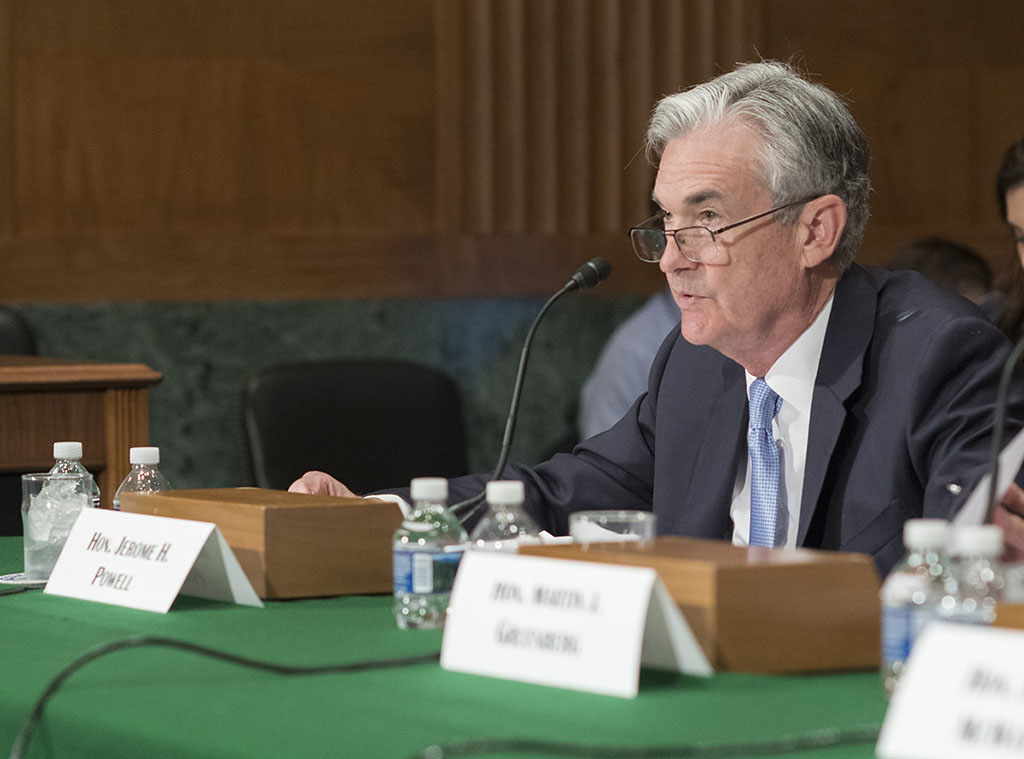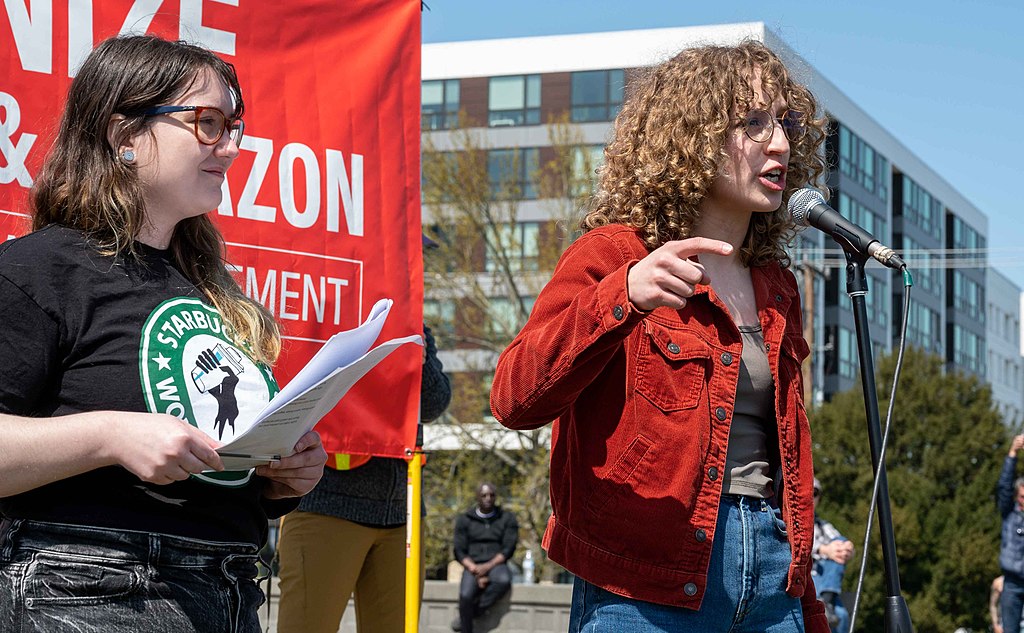The Fed’s inflation plan is class war
Labor needs its own politics to fight back

The U.S. labor movement is at a critical crossroads. The old movement is dying, and the new movement is in its precarious newborn state. The U.S. establishment sees labor’s baby and has reached for a pillow to smother it. In this case the Federal Reserve will do the smothering, having served the establishment well in times of crisis.
The Federal Reserve banking system is especially revered by the savvier capitalists for its role in the historic victory that corporations won over unions in the early 1980s that is celebrated by the wealthy to this day. Its infamous “Volcker shock” drove up interest rates in order to trigger high unemployment, which was used by Ronald Reagan to launch an attack on unions that decimated what recently had been a militant and strong labor movement. This one-two punch basically knocked out unions for 40 years. The result was a restructuring of labor relations that allowed unchallenged corporate dominance, creating absolute misery at work for ever-growing millions of people.
The top union officials mostly went along with the new normal, collaborating with employers—with the Democratic Party often acting as intermediary—in a decades-long process of concessionary union contracts that weakened the rapidly shrinking labor movement.

Reagan’s defeat of unions was arguably the most important pillar of capitalism’s so-called “neoliberal” era—an economy rooted in structural low wages with a very “flexible labor market.” This was the precondition for companies like Walmart, Amazon, and Starbucks to flourish, and helped facilitate the auto industry’s—and other manufacturers—migration to the South and overseas in search of lower wages. It also resulted in a deeply unequal society with soaring poverty rates and their associated evils: addiction, mental illness, homelessness, domestic violence, mass shootings, etc.
The key economic weapon of Reagan’s success, the Federal Reserve banking system, aka “the Fed,” is now being re-deployed at another critical juncture of U.S. history. Behind the talk of “beating inflation” is a thinly-veiled strategy of beating the working class into submission, with the Fed delivering the key blow.
Beating inflation by lowering wages
There are many signs that the U.S. establishment has united around a 2022 version of the Volker Shock—specifically targeting wages and the labor movement—to stem inflation while using the resulting economic environment to crush a union upsurge.
On July 13 it was announced that the annual inflation rate in June was 9.1 percent, the highest increase since 1981. News outlets everywhere demanded a Fed rate increase to drive down inflation (after the previous month’s already-high increase). These demands on the Fed typically ignore the deeper motive—reducing wages—but occasionally the establishment speaks openly.
For example, even before June’s inflation numbers were released, the New York Times was announcing the tragedy of the June jobs report, which reported that wages and hiring increased. What normally is considered good news (low unemployment, rising wages) triggered three separate articles on the front page of the Times that prompted the Fed to take “strong action.”
One of the three articles was especially revealing, “Wages climbed 5.1 percent in June, a rapid pace offering little hope for the Fed.” The Fed, according to the Times, doesn’t like wage increases, a sentiment echoed by a growing chorus of establishment voices insisting that “the labor market is overheated,” etc.
One example is former Treasury Secretary Larry Summers, who recently said: “We need five years of unemployment above 5 percent to contain inflation … or one year of 10 percent unemployment…” Summers and many others want higher unemployment because it leads directly to lower wages (when the supply of labor outpaces demand, wages decrease).
The Fed’s current Chairman, Jerome Powell, has been saying the same thing, in coded language. In June, Powell said, “Wages are not principally responsible for the inflation that we’re seeing, but going forward, they would be very important…”

Powell has said several times recently that the Fed will strive to “moderate demand” [for workers] in the labor market, i.e., raise interest rates to create a recession that creates unemployment.
While many celebrated that the July inflation rate was “only” 8.5 percent compared to June’s 9.1 percent, the deeper “problem” for the Fed is that unemployment shrank even further, keeping the labor market “red hot,” i.e. too hot for employers.
The Washington Post confirmed: “the surprisingly hot [July] jobs report renewed some fears that the Federal Reserve will need to aggressively raise interest rates to cool the economy down …”
Several key Fed members have expressed their “commitment” to taming inflation/the labor market. The July job statistics mean more Fed rate hikes in the near future until its actual goal is achieved: lowering wages by throwing people out of work.
This puts the labor movement in the crosshairs, since a primary duty of organized labor is to keep wages as high as possible. Powell’s words must also be viewed in the political context of a rising labor movement threatening giant corporations like Starbucks and Amazon.
Fighting inflation by fighting unions
One unexpected outcome of COVID-19 was a labor market that favored labor, for the first time in decades. The so-called Great Resignation gave enormous bargaining power to most workers, since they were in short supply, and employers were desperate.
This is especially true for the lowest rung of the working class, which big business depends on for hyper-exploitation. U.S. capitalism simply does not tolerate this section of workers winning higher wages. Raising the lowest rung of the wage scale tends to push the neighboring rungs higher, at which point the whole edifice of profit-making begins to shake.
The Fed started getting jittery last fall after bidding wars for labor erupted between Amazon, UPS, Federal Express and other warehouse/transport employers. Wages skyrocketed. The service industry was similarly rocked, with low-wage workers switching jobs at unprecedented rates chasing the highest bidder. Suddenly long-exploited truckers could name their price.
Consequently, $15 is now the de facto minimum wage for much of the nation. The low-wage workers who normally struggle to survive suddenly gained confidence as they saw the value of their labor soar. A confident and organized working class is a dangerous one for an economic system based on exploiting labor to make profit.
Unions didn’t create this dynamic, but they have benefited from it. It’s in this context of a worker-friendly labor market that important strikes have been waged at John Deere, Kellogg and Nabisco, not to mention a teacher strike wave that hasn’t stopped since 2018. Hospital workers in various states are making militant demands for better pay for their devastating working conditions, at a time when hospitals are desperate for workers.
New organizing victories at Amazon and Starbucks would likely not be so successful without the pro-worker labor market. The already-difficult task of winning a union contract at Amazon or Starbucks will get harder still if the Fed succeeds at raising unemployment, since the newly-unemployed can be used essentially as strikebreakers.

It’s noteworthy to mention the internal Amazon memo that warned that the company is running out of workers nationwide. For a company that depends on 100 percent turnover—and there are many—this is a very dangerous situation.
Also urgent to the corporate and political establishment is that workers are now demanding wage increases that mirror growing inflation, putting extra pressure on profits (referred to as a “wage-price spiral” by economists). Instead of using price controls or other mechanisms, however, only wages are being targeted.
Can labor win?
Labor has real momentum on its side, and it can win. But it’s also possible that a capitalist counter-attack could make the already-small labor movement shrink further—into the shell it resembled before the labor uprisings of the 1930s.There have been two critical moments in U.S. history where a militant labor movement was shattered by joint action from the government and employers.
From about 1895 to 1933, the U.S. labor movement was crushed by joint employer-state repression that targeted militant mass movements (such as the 8-hour day) and national strike waves (that included the Pullman, Homestead and Cripple Creek strikes).
After decades of hibernation the labor movement was reborn, lasting from 1933 to 1980. In the 1970s, the high-profit era of the postwar boom was over, while the labor movement remained too strong for the establishment to stomach. High inflation was the excuse used to launch another historic assault led by Reagan in the 1980s, prepared by the Fed’s rate hike.
We may be at a similar historic juncture to 1933, where the union movement began to crawl out of its decades of marginalization. The momentum that exists today is real, though it’s too soon to know if it’s the kind of unstoppable upswing that birthed the CIO and restructured the nation’s class balance of power.
Today’s labor movement, while dynamic, remains fragile. Public sector unions continue to bleed members from the gaping wound caused by the Supreme Court’s 2018 attack “Janus vs. AFSCME.” In his important new book, Class Struggle Unionism, Joe Burns commented on the current state of the labor movement: “we’re getting our asses kicked.” Burns acknowledges the inspiring rank and file led campaigns at Starbucks, Amazon, etc, but ultimately he describes an overall movement that has continued to backslide. Last year union membership dropped by around 300,000.
A very bright spot, however, is that filings for new unions have risen dramatically this year, though the long-term viability of many of these unions depend on a variety of factors, including the Fed’s ability to tank the labor market.
While public sentiment—especially among younger people—increasingly favors unions, these feelings need organized expression and, equally important, independent and powerful politics. The employers cannot continue to have a monopoly on politics in a time of social crisis.
Labor needs labor politics
Politics is one glaring weakness of today’s labor movement. Because there is no workers’ party, unions have relied on the Democrats, a party dominated by billionaires who own companies like Amazon, Starbucks and Facebook. Imagine a herd of buffalo that stakes its future on the kindness of wolves.
Since President Bill Clinton, Democrats have dropped all pretense and are explicitly pro-corporate. Kim Moody’s excellent new book, Breaking the Impasse, outlines the evolution of the wealthy’s complete dominance over the Democrats while labor’s influence has shriveled to irrelevance.
Consequently, many on the Left chose to ignore politics, to focus exclusively on the labor movement. But this too is problematic. Ignoring politics means, in practice, that you’ve accepted the political status quo, which means ultimately unions will return, groveling, to the Democrats.
The Fed is a good example of the problem. The supply of money and how it’s distributed is a deeply political question, and currently there is bipartisan consensus. Trump appointed the current Fed Chairman because Jerome Powell is a reliable representative of Wall Street: He led a major deregulation of Wall Street before using the Fed to bail out the biggest corporations when COVID-19 struck, which led to a massive rise in the stock market at a time when the country was largely shut down. This creation of trillions of speculative capital surely played a role in today’s inflation, making more billions for billionaires.
Many believed that Biden would replace Powell with a more progressive Fed chairman. But Biden kept Trump’s pick, and the Democratic Party kept their mouths’ shut. They have also been silent about Powell’s many ominous comments about “fixing” the labor market.
The Democrats vs. inflation
The Fed-complicit Democrats have also refused to speak out against the war in Ukraine, which has been a major contributor to high gas prices and inflation in general. The Democrats are fueling this U.S. proxy war, having already sent over around $60 billion to keep the war going. There is virtually zero opposition among Democrats (all who agree that the conflict is contributing to global inflation). The Democrats then went on to pass an annual record military budget—another contributor to inflation—of $840 billion.
Another obvious source of inflation is the U.S. fossil fuel industry, which is making record profits because of the global oil shortage; these profits go to wealthy investors while the price at the pump soars. Not only did the oil industry get bailed out by the Fed during COVID-19, the entire U.S. fossil fuel infrastructure is made profitable by enormous tax subsidies that climate activists have demanded that Biden stop. Instead, he’s proven himself to be a dependable ally of the oil and gas companies at a time of cascading climate crisis.
Another source of inflation is the soaring cost of housing, which the Democrat establishment continues to ignore. The homelessness crisis has accelerated in step with the rising costs of rent, which guarantees to worsen as the Fed raises interest rates, since home loans will be unaffordable and thus will push people into an already overcrowded rental market.
Instead of targeting these causes of inflation, workers are being targeted, as demanded by the billionaires who rule the Democratic party. Organized labor cannot continue to allow itself to be muzzled by the Democrats at a time of historic and worsening crisis.
The labor movement needs a recession action plan
Unions have a duty to warn and educate their members about the Fed-triggered recession, and what it could mean for their wallet, union, and community. As opposed to the class collaborationist approach of tailing Democratic Party politicians who in turn support the Feds’ actions, the unions should wage a powerful class struggle campaign. This should be directed at the Fed attacks—and the various crises now facing society. Millions would pour into the movement if such a campaign were undertaken. Labor activists need to agitate to push their unions in this direction.
Protest movements have erupted all over the world in reaction to the inflation/capitalist crisis. In Britain a campaign called Enough is Enough was formed by labor and community groups to organize a pro-worker solution to the crisis. In the United States, the attachment of labor and “socialists” to the Democrats has delayed the development of a movement to address the growing crisis, but such a movement is desperately needed.
A pillar demand of such a movement must be living-wage jobs, which are scarce after 40 years of neoliberalism. The labor movement can return to its roots by demanding full employment to counter the Fed’s plan to create mass unemployment. (The AFL and CIO championed full employment during the massive strike wave of 1945-1946.)
A labor action plan must demand that the inflation crisis be addressed by other means. Price controls on key goods should be demanded that force shareholders to eat lower profits. Controlling the price of health care—via a single-payer plan—may also help stem inflation. Other options include: nationalizing the U.S. fossil fuel industry that’s making super profits from high gas prices; ending the massive, bi-partisan increases in military spending; or stabilizing the price of rent by winning national rent control.
Nationalizing the Wall Street banks that steer the Fed is also necessary, since money can be distributed according to social need while student debt forgiveness—and other high interest debt—can be easily reduced or forgiven, while desperately needed funds to plan for the climate crisis can be made available.
All of these solutions can also be subsidized by massive tax increases on the wealthy.
Getting unions to take up demands like these will require rank and file agitation on a major scale. The Left needs to take some politics into its labor work.
The urgency of the moment
Ultimately there is too much at stake at home and abroad in 2022 to leave politics to the Democrats. After 40 years of shredding the social safety net, U.S. society cannot digest another deep recession without barbaric levels of suffering: Poverty, homelessness and addiction will soar much further while general hopelessness grips broader layers of people.
While agitating for immediate solutions to the crisis, union activists should also explain the desperate need for a third party—not a third capitalist party but rather a mass party of workers. A key part in the creation of such a party is insisting that unions and socialist organizations prioritize its creation. Without ongoing discussion and agitation this necessity will be ignored by those movement “leaders” who are ultimately content with the status quo.
Doing rank and file organizing is simply not enough, and it never was. Socialists critiqued this approach a 100 years ago when it was called “pure and simple” unionism that the labor bureaucrats preferred. Militant unionism without militant politics eventually gets smothered by corporate political parties, who aggressively come to the rescue of the targeted employers, such as the Fed is doing now.
The labor movement can provide real hope for the future, and fast: by fighting for a set of inspiring demands while also taking steps toward a new party. Energy can be funneled fast in times of crisis. For example, the Republican party was quickly created to address the pre-Civil War crisis: Lincoln was immediately elected, and together with a mass movement of newly-freed slaves, society was quickly transformed.
Today we stand at a similar precipice in front of a deepening social and climate crisis. A rejuvenated labor movement attached to a new party of working people is capable of breaking through the current impasse, while offering political guidance through what promises to be an increasingly difficult historic period.
Featured Image Credit: Photo by RME Gold, art courtesy of FreeSVG.org; modified by Tempest.
Categories
We want to hear what you think. Contact us at editors@tempestmag.org. And if you've enjoyed what you've read, please consider donating to support our work:
DonateShamus Cooke View All
Shamus Cooke is a social service worker and trade unionist in Portland, OR. He can be reached at shamuscooke@gmail.com.
